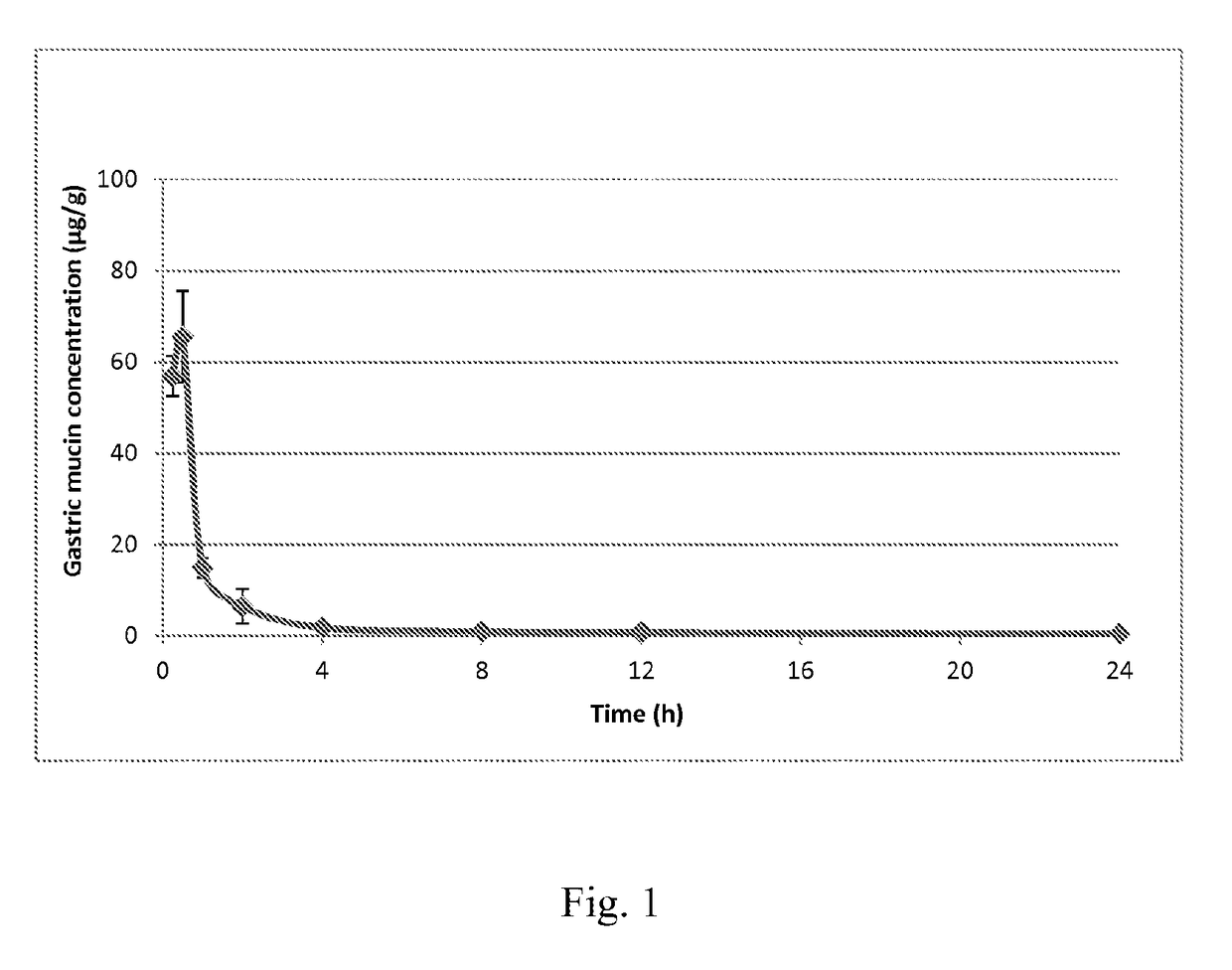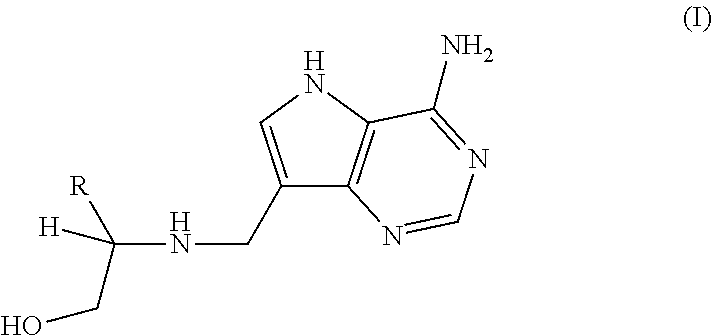Treatment of h. pylori infections using mtan inhibitors
a technology of mtan inhibitors and h. pylori, which is applied in the field of treating infections due to helicobacter pylori, can solve the problems of increasing the difficulty of eradicating i>h. pylori/i>, and achieve the effect of inhibiting the growth of h
- Summary
- Abstract
- Description
- Claims
- Application Information
AI Technical Summary
Benefits of technology
Problems solved by technology
Method used
Image
Examples
example a
of 2-[({4-amino-5H-pyrrolo[3,2-d]pyrimidin-7-yl}methyl)amino]ethan-1-ol (A.1)
[0044]
2-[({4-Amino-5H-pyrrolo[3,2-d]pyrimidin-7-yl}methyl)amino]ethan-1-ol (A.1)
[0045]2-Aminoethanol (0.099 mL, 1.64 mmol), 9-deazaadenine (0.220 g, 1.64 mmol) and aq. formaldehyde solution (37%, 0.15 mL, 1.99 mmol) were stirred together in tert-butanol (3 mL) at 70° C. for 16 h. Silica gel was added to absorb all the solvent then the solvent was evaporated and the residue purified by chromatography on silica gel (CHCl3-MeOH-28% aq.NH4OH, 70:25:5). Fractions containing product were evaporated and the residue chromatographed again on silica gel (2-PrOH-28% aq. NH4OH, 92:8) to give A.1 as a colourless solid (0.101 g, 30%). 1H NMR (500 MHz, CD3OD): δ 8.16 (s, 1H), 7.47 (s, 1H), 3.95 (s, 2H), 3.68 (t, J=5.6 Hz, 2H), 2.78 (t, J=5.6 Hz, 2H). 13C NMR (125.7 MHz, CD3OD, centre lined 49.0): δ 152.1 (C), 150.9 (CH), 146.6 (C), 129.0 (CH), 115.4 (C), 114.4 (C), 61.6 (CH2), 51.6 (CH2), 43.4 (CH2). ESI-HRMS calcd for C9...
example b
of (2S)-2-[({4-amino-5H-pyrrolo[3,2-d]pyrimidin-7-yl}methyl)amino]propan-1-ol (B.1)
[0046]
(2S)-2-[({4-Amino-5H-pyrrolo[3,2-d]pyrimidin-7-yl}methyl)amino]propan-1-ol (B.1)
[0047](2S)-2-Aminopropan-1-ol (0.120 g, 1.60 mmol), 9-deazaadenine (0.179 g, 1.33 mmol) and aq. formaldehyde solution (37%, 0.12 mL, 1.60 mmol) were stirred together in tert-butanol (3 mL) at 70° C. for 16 h. Silica gel was added to absorb all the solvent then the solvent was evaporated and the residue purified by chromatography on silica gel (CHCl3-MeOH-28% aq.NH4OH, 80:18.5:1.5) to afford B.1 as a colourless solid (0.180 g, 61%). 1H NMR (500 MHz, CD3OD): δ 8.16 (s, 1H), 7.47 (s, 1H), 4.01 (d, J=13.6 Hz, 1H), 3.92 (d, J=13.6 Hz, 1H), 3.54 (dd, J=11.0, 4.8 Hz, 1H), 3.43 (dd, J=11.0, 7.0 Hz, 1H), 2.84 (m, 1H), 1.09 (d, J=6.5 Hz, 3H). 13C NMR (125.7 MHz, CD3OD, centre line δ 49.0): δ 152.1 (C), 150.9 (CH), 146.5 (C), 128.9 (CH), 115.4 (C), 114.5 (C), 66.6 (CH2), 54.8 (CH), 41.0 (CH2), 16.5 (CH3). ESI-HRMS calcd for C10...
example c
of (2S)-2-[({4-amino-5H-pyrrolo[3,2-d]pyrimidin-7-yl}methyl)amino]butan-1-ol (C.1)
[0048]
[0049](2S)-2-[({4-Amino-5H-pyrrolo[3,2-d]pyrimidin-7-yl}methyl)amino]butan-1-ol (C.1).
[0050](2S)-2-Aminobutan-1-ol (0.100 g, 1.12 mmol), 9-deazaadenine (0.150 g, 1.12 mmol) and aq. formaldehyde solution (37%, 0.101 mL, 1.35 mmol) were stirred together in tert-butanol (3 mL) at 70° C. for 16 h. Silica gel was added to absorb all the solvent then the solvent was evaporated and the residue purified by chromatography on silica gel (CHCl3-7M NH3 / MeOH, 9:1 then 85:15) to afford C.1 as a colourless solid (0.133 g, 50%). 1H NMR (500 MHz, CD3OD): δ 8.16 (s, 1H), 7.47 (s, 1H), 3.99 (d, J=13.6 Hz, 1H), 3.95 (d, J=13.6 Hz, 1H), 3.67 (dd, J=11.2, 4.4 Hz, 1H), 3.48 (dd, J=11.2, 6.5 Hz, 1H), 2.61 (m, 1H), 1.62-1.53 (m, 1H), 1.51-1.42 (m, 1H), 0.91 (t, J=7.5 Hz, 3H). 13C NMR (125.7 MHz, CD3OD, centre line δ 49.0): δ 152.1 (C), 150.8 (CH), 146.6 (C), 128.9 (CH), 115.4 (C), 114.8 (C), 63.9 (CH2), 60.9 (CH), 41.1 (...
PUM
 Login to View More
Login to View More Abstract
Description
Claims
Application Information
 Login to View More
Login to View More - R&D
- Intellectual Property
- Life Sciences
- Materials
- Tech Scout
- Unparalleled Data Quality
- Higher Quality Content
- 60% Fewer Hallucinations
Browse by: Latest US Patents, China's latest patents, Technical Efficacy Thesaurus, Application Domain, Technology Topic, Popular Technical Reports.
© 2025 PatSnap. All rights reserved.Legal|Privacy policy|Modern Slavery Act Transparency Statement|Sitemap|About US| Contact US: help@patsnap.com



